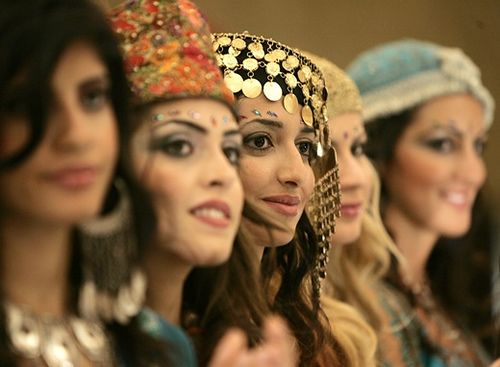 I am the last person anyone should go to for fashion advice, but I do recognize the importance of fashion and what it says about a society. So with that in mind, I found the recent spate of stories on the shifting mindset of women in two major Middle Eastern countries toward fashion a fascinating look inside the countries' culture.
To say that female fashion is driven by religion in Saudi Arabia and Iran is an understatement. But that is not saying that the two Middle Eastern giants are anywhere close to being similar in their approach to fashion. Just compare the leading fashion descriptions in a Los Angeles Times piece by Borzou Daragahi on illicit fashion shows in Tehran and a Washington Post piece by Faiza Saleh Ambah on the colorful abayas that are all the rage in Saudi Arabia.
I am the last person anyone should go to for fashion advice, but I do recognize the importance of fashion and what it says about a society. So with that in mind, I found the recent spate of stories on the shifting mindset of women in two major Middle Eastern countries toward fashion a fascinating look inside the countries' culture.
To say that female fashion is driven by religion in Saudi Arabia and Iran is an understatement. But that is not saying that the two Middle Eastern giants are anywhere close to being similar in their approach to fashion. Just compare the leading fashion descriptions in a Los Angeles Times piece by Borzou Daragahi on illicit fashion shows in Tehran and a Washington Post piece by Faiza Saleh Ambah on the colorful abayas that are all the rage in Saudi Arabia.
Here's the LAT:
Amid air kisses and gossip, techno and hip-hop music thumps. The guests slide out of dark overcoats to unsheathe daringly low-cut dresses and open-slit gowns, form-fitting sweaters and go-go boots, skin-tight T-shirts and acid-washed jeans. Skinny, long-legged models giggle as they slip into outfits of satin and silk. A red carpet serves as a runway.
And the Post:
When Fageeh, a health industry executive, appeared at a recent business conference in a floor-length white abaya made of light cotton and monogrammed with an M, some of the attendees were shocked, she said. But others were inspired.
The LAT piece does little to explore the theological background of Iran's fashion laws. The Post piece explores the history nicely but does little to explain why the country's enforcement of the law has become less stringent. For instance, why has the influence of the Commission for the Promotion of Virtue and the Prevention of Vice waned since the Sept. 11 attacks? Nothing in the article convinces me that this date is significant in Middle Eastern fashion. For all I know, it is merely a coincidence.
Here is the Post on why conservative Muslims support laws restricting women's fashion:
Many conservatives see the new abaya as sinful, and orthodox clerics have issued fatwas, or edicts, decreeing that the robes must be dark, loose and shapeless.
The varied views here on women's dress stem from different interpretations of Koranic verses and hadith, anecdotes about Islam's prophet Muhammad and his followers that are considered an important source of religious practice and law. Though there is no consensus among Muslims regarding what constitutes proper dress, most believe that God ordered women to wear loose clothing that covers their contours.
The first verse in the Koran that deals with the Islamic dress code for women says: "O Prophet! Tell thy wives and thy daughters and the women of the believers to draw their cloaks close round them (when they go abroad). That will be better, so that they may be recognized and not annoyed. Allah is ever Forgiving, Merciful."
The day that verse came to Muhammad from Allah, according to hadith, women walked to dawn prayers "looking like crows." Ahmad al-Mussaed, a geography professor and the author of several books on traditional clothing, said Muslim women should therefore dress in black abayas to follow the example of women during the time of the prophet.
Anytime someone writes about the Middle East, it inevitably involves Islam. This is particularly true here. The Post piece does a great job explaining how the letter of the law is often what people seek to follow while skirting (apologies for the pun) the spirit of the law.
